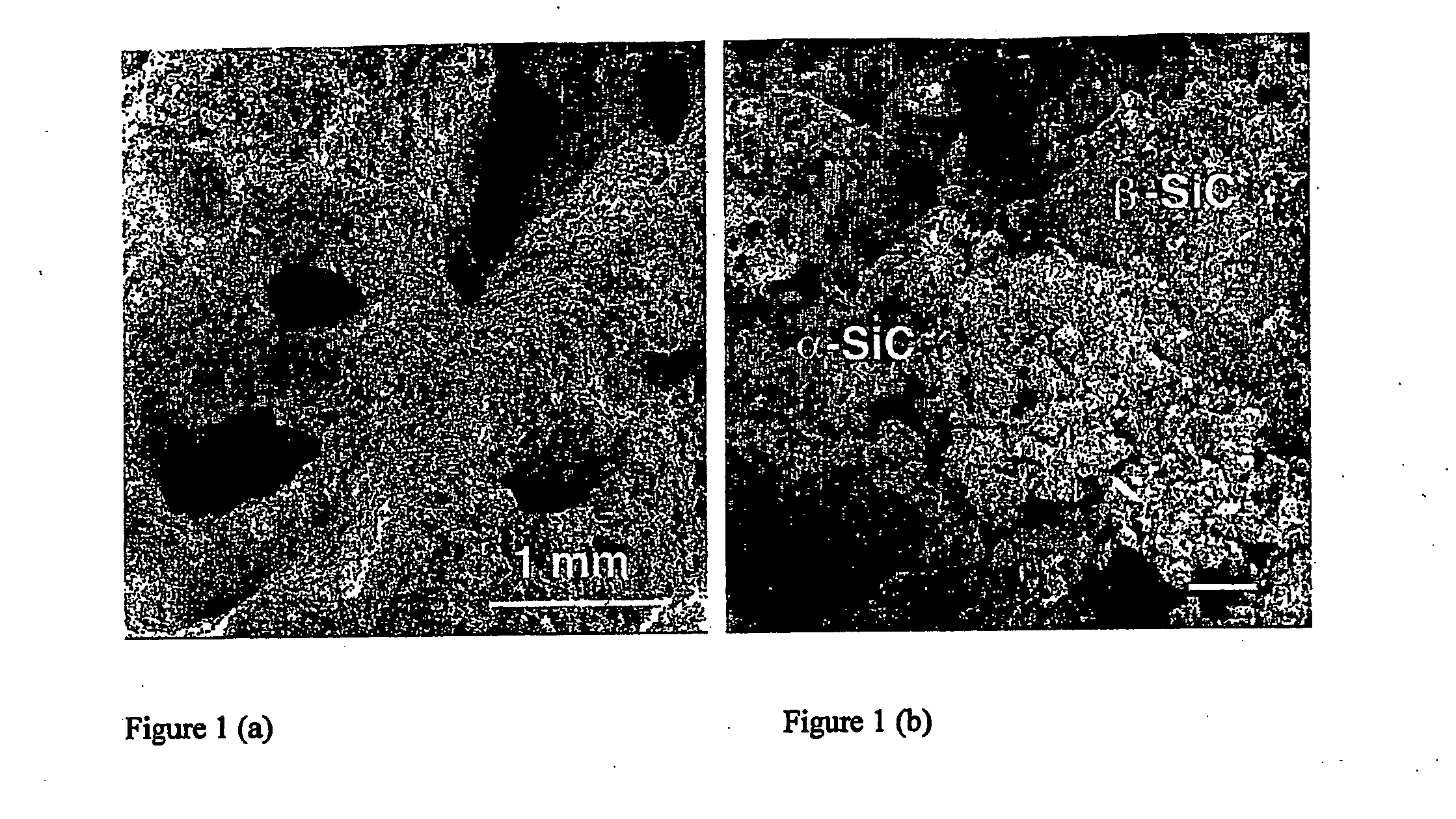Use of a silicon carbide-based ceramic material in aggressive environments
a ceramic material and silicon carbide technology, applied in the field of ceramic materials for use in aggressive environments, can solve the problems of the relatively high the inability to fully dissolve the binder, and the inability to achieve the effect of reducing the cost of the binder,
- Summary
- Abstract
- Description
- Claims
- Application Information
AI Technical Summary
Benefits of technology
Problems solved by technology
Method used
Image
Examples
example 1
Production of β-SiC Panels Without Inclusions
[0063] 1500 g of silicon powder (grain size focused on 7 μm), 560 g of carbon black (grain size focused on 20 nm) and 1000 g of phenolic resin are mixed in a mixer.
[0064] The paste obtained in this way is then compressed between two flat surfaces to obtain a 3 mm thick panel. This panel is hardened by heating at 200° C. for 3 hours. During this step, a weight loss corresponding to approximately 10% of the initial weight of the mixture is observed. The element obtained is easy to handle and has a smooth surface appearance.
[0065] Said element is then subject to progressive heating under a flow of argon at atmospheric pressure up to 1360° C., and it is then kept at this temperature for one hour. The element is then allowed to cool to ambient temperature. During this step, a weight loss corresponding to approximately 13.5% of the hardened element is observed. The appearance of the material is black as it still contains 7% free carbon.
[006...
example 2
Production of β-SiC Panels with α-SiC Inclusion (α-SiC / β-SiC Composite)
Alternative Embodiment (a)
[0068] 4.5 g of silicon powder (average particle diameter: approximately 7 μm) is mixed with 5.5 g of a phenolic resin providing the source of carbon required for the carburisation to form the β-SiC intended to act as a binder in the final composite. 7 g of α-SiC in powder form is added to this mixture as a source of inclusions. The mixture was shaped by means of moulding.
[0069] The whole is polymerised in air at 150° C. for 2 hrs. The weight loss during this polymerisation was 2 grams. The solid obtained in this way is subjected to a heat treatment in a dynamic vacuum at 1300° C. with a temperature rise slope of 5° C. min−1. During the temperature rise, the polymerised resin is carbonised and results, at high temperatures, in a carbon network in close contact with the silicon grains, facilitating SiC synthesis. The composite is kept at this temperature for 2 hrs so as to convert the ...
embodiment (
Alternative Embodiment (b)
[0073] In other alternative embodiment, a mixture of 4.5 g of silicon powder, 5.5 g of phenolic resin and 73 g of α-SiC grains is produced. The mixture is shaped by means of pressing such that the resin and the silicon powder fill most of the free volume between the α-SiC grains.
[0074] The same procedure as for example 2(a) is then followed.
[0075] The product obtained then consists of a mixture of 91% α-SiC bound with 9% β-SiC and has a density of 2.5 g / cm3 with an open porosity of less than 20%.
PUM
| Property | Measurement | Unit |
|---|---|---|
| density | aaaaa | aaaaa |
| density | aaaaa | aaaaa |
| temperatures | aaaaa | aaaaa |
Abstract
Description
Claims
Application Information
 Login to View More
Login to View More - R&D
- Intellectual Property
- Life Sciences
- Materials
- Tech Scout
- Unparalleled Data Quality
- Higher Quality Content
- 60% Fewer Hallucinations
Browse by: Latest US Patents, China's latest patents, Technical Efficacy Thesaurus, Application Domain, Technology Topic, Popular Technical Reports.
© 2025 PatSnap. All rights reserved.Legal|Privacy policy|Modern Slavery Act Transparency Statement|Sitemap|About US| Contact US: help@patsnap.com


